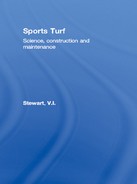Simple tests for Stewart zone materials
For all materials it is assumed here that particle shape and mineral composition is satisfactory.
B.1
Stewart zone topsoil sand (uniform fine sand)
Often, small local suppliers are unable to provide numerical data to assist with the selection of appropriate sands. However, they are usually aware of the general nature of their materials and describe them either in terms of their use, or their source. Sands, described variously as dune, building, plaster, masonry, foundry or filter sands are all candidates for consideration as topsoil sands. First eliminate the coarse, concreting and horticultural sharp sands by carrying out the sieve tests in section B.2 below. Use can then be made of a simple, infiltration test to weed out those that are too fine and dusty to do the job efficiently.
To carry out the hydraulic conductivity test use a cylindrical container, ideally 100– 150 mm (4–6 in) tall, such as an old tin or plastic flower pot with the base removed and replaced by a muslin-covered fine mesh filter. The muslin should not be so coarse as to allow more than dust through from the fine sand, and should not be so fine as to prevent water passing through in a matter of seconds rather than minutes.
With the filter in place, fill the container half full of the fine sand under test, leaving 75 mm (3 in) empty above. Stand in a bowl so that the base of the container will allow water access from below. Fill the outer bowl with water to above the level of the sand in the inner container, maintaining this level until the surface of the sand within the container becomes wet. Tap the container to eliminate air bubbles and settle the sand, then top up with more sand if necessary to compensate for any fall below halfway. Fill both the outer bowl and inner container with water until flush with the rim of the inner, sand-filled container.
Starting with the sand container brimming with water, lift it out of the bowl, resting it on a makeshift stand that will allow free drainage. Note the time taken for the water level in the sand container to fall from the rim of the container to the surface of the sand. The sand taking the least time to clear the 75 mm (3 in) column of water, from the rim to the surface of the sand, will be the best. Times taken may vary from a few minutes to a few hours, but a suitable material would take something of the order of 5–10 minutes.
B.2
Stewart zone blinding sand
The hydraulic conductivity test is not alone sufficient for selecting Stewart zone blinding sands from amongst fine sands, concreting sands or sharp sands. Its hydraulic conductivity, measured in the manner described in section B.1, is similar to or only a little faster than that of a Stewart zone topsoil sand, i.e. typically 1–5 minutes. However, it will have to be distinguished further by having 20–50% of coarse particles larger than 1 mm (i.e. failing to pass a domestic flour sieve).
B.3
Stewart zone trench gravel
A typical Stewart zone trench gravel will have 90% of particles between 2 mm in) and 12 mm (1/2 in) in effective diameter, with the great majority close to 6 mm (1/4 in). This can be checked by using appropriate sieves or, more simply, by direct measurement of individual particles, using a ruler.
